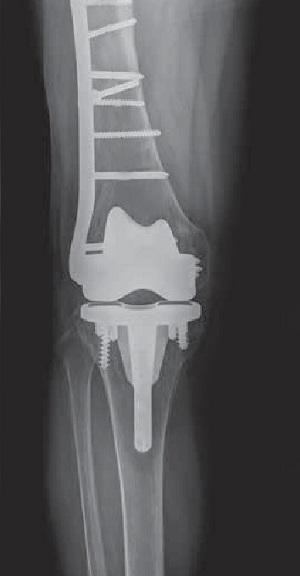
What is Periprosthetic Knee Fracture Fixation?
Periprosthetic knee fracture fixation is a procedure performed to stabilize a fracture that occurs in the bone present around a knee prosthesis. The fracture may involve the lower part of the thighbone (femur), the kneecap (patella) or the upper part of the shinbone (tibia).
Indications for Periprosthetic Knee Fracture Fixation
Periprosthetic knee fracture fixation is indicated for fractures around the knee prosthesis, which may occur due to:
- Anterior femoral cortical notching (damage to the thighbone during the knee replacement procedure)
- Use of a rotationally constrained implant that may place a lot of stress on the bone
- Loose implant components
- Implant malalignment
- Implant malposition
- Rheumatoid arthritis
- Steroid use
- Osteonecrosis (death of bone)
Methods for Periprosthetic Knee Fracture Fixation
The methods for periprosthetic fracture fixation will vary depending on the type of fracture and the stability of the implant.
Nonsurgical Periprosthetic Knee Fracture Fixation
Conservative treatment may be used for periprosthetic knee fracture fixation if the knee prosthesis is stable. The treatment involves cast fixation and not bearing weight on the knee for approximately 6 weeks.
Surgical Periprosthetic Knee Fracture Fixation
In most cases, surgical treatment is recommended to ensure good function of the knee prosthesis. The various surgical options include:
- Intramedullary nailing: A specially designed nail is inserted through the hollow center of the bone (the medullary cavity). The nail acts as an internal splint to stabilize the fracture.
- Plate and screw Fixation: Plates and screws allow for excellent fixation in case of complex fractures, protecting the knee prosthesis from undue stress. Nonlocking screws may also be used in some cases to help reduce the fracture.
- Revision Prosthesis: When there is a loosening of the prosthesis, the whole implant will usually have to be surgically removed and replaced with a hinged knee prosthesis, which can be considered a salvage device that provides better stability to the knee.
Postoperative Care after Periprosthetic Knee Fracture Fixation
It is very important for patients to be mobilized as soon as possible after periprosthetic knee fracture fixation as this will help prevent health problems associated with immobilization. In most cases, your doctor will recommend partial weight-bearing using assistive devices for the first 1-1/2 months after surgery.
